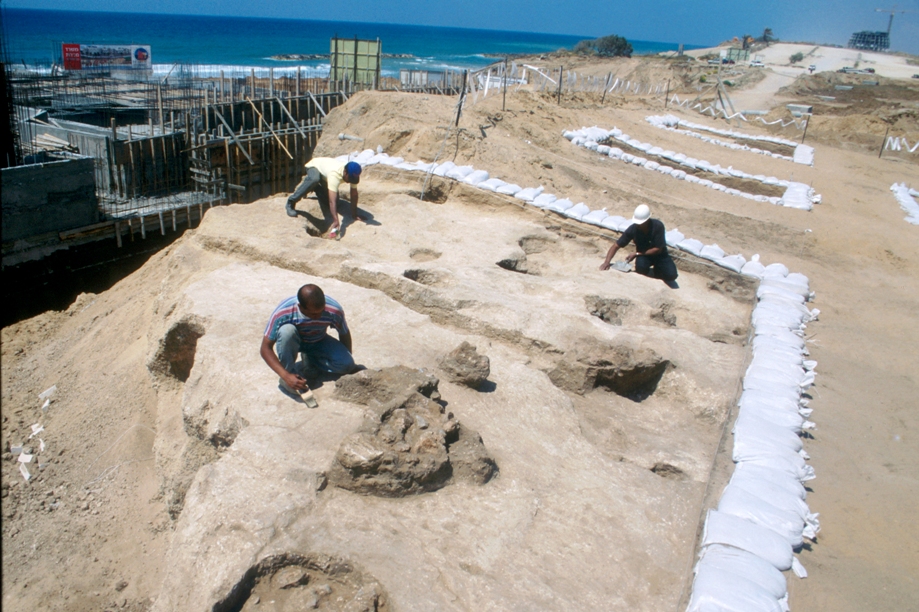
PHOTO: wikimedia
ASHKELON CEMETERY, ISRAEL – Archaeologists have made an incredible discovery along Israel’s coast: a 3,000 year-old Philistine cemetery that’s proving to provide an invaluable look at this ancient civilization.
The Philistines were an ancient people that lived in the area of what is now present-day Israel. They’re most famous for being a warlike people that had constant conflict with ancient Israel. We primarily know about them from the Bible, but they were first confirmed to exist historically when archaeologists found reliefs in Egypt at the Temple of Ramses III that mentioned the warlike civilization. Assyrian sources have also written about them.
We know very little about what life was like for the average Philistine, and archaeologists can’t even agree on their burial practices since no formal burial ground has been discovered in a Philistine city… until now.
“For the first time, we have found a formal Philistine cemetery,” Adam Aja, an archaeologist and excavation director working with the Harvard Semitic Museum said.
It’s an immense find. Archaeologists and historians have been debating about Philistine burial practices for a hundred years. Finally, at Ashkelon, they’ve discovered an unprecedented burial ground that’s yielding some terrific information about what the Philistines were like three-thousand years ago.
A Nation in Crisis
At Ashkelon, the archaeologists have discovered the remains of an estimated 1,200 people that were buried there over the course of a hundred years, giving us a snapshot look of what the Philistine population looked like during that time.
Most of the Philistine dead were buried in very shallowly dug pits. Often, the dead had been laid on top of older bodies. Like most contemporary graves in the area, the bodies had been buried with a number of grave goods. Most had jars and storage containers buried with them. The women and children were commonly adorned with bronze earrings, bracelets, rings, and other jewelry, while the men were buried with engraved stones and ornamental beads.
One man even has a set of iron arrows buried with him, suggesting he was a hunter or a warrior in life. Site-leader Adam Aja believes that the arrows were once contained a quiver that has since rotted away.
It seems, however, that the Philistines didn’t have just one way to bury their dead. Archaeologists also found twenty-three other graves, but these were carved out of stone and capped with stone slabs. It’s unclear as of now whether or not these graves were made for more prestigious members of Philistine society or not, but that would be likely.
Yet, the variety in burials doesn’t stop there. Sealed jars left in pit graves also contained bone fragments and cremated human remains.
The research is still in its early stages, but archaeologists have already begun to analyze the human remains found at Ashkelon, and they’re finding a story of social stress and crisis.
The Philistine bodies buried at Ashkelon have relatively short heights. The men average out at 5 feet, 1 inch, and the women average at 4 feet, 10 inches. Sherry Fox, bioarchaeologist with Eastern Michigan University explained that when a population comes under stress from malnutrition, men and women develop only slight height differences, and the population as a whole is shorter.
While the population showed many other signs of physical stress, perhaps the strangest thing about them is that none of the bodies had any signs of tumors or cancers, or even any head injuries or signs of violence. The Philistines were an extremely warlike culture, so it seems odd that none of the bodies buried there seemed to have died from injuries sustained in battle. This suggests that the Philistines buried their honored dead at another location, separate from the rest.
The most exciting prospect of a find this large, however, is the possibility of extracting DNA from any of the Ashkelon remains. Archaeologists have yet to confirm where the Philistines came from, and when their civilization first began. If DNA can be extracted and analyzed, it may settle an age-old debate.
Adam Aja and his team of researchers will continue to work on the site at Ashkelon. There’s still so much more to do and learn. The months ahead should reveal more information about this incredible find.


